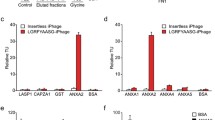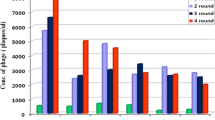Abstract
Galectin-3 (gal-3) is involved in the metastatic cascade and interacts with the cancer-associated carbohydrate, Thomsen-Freidenreich (TF) antigen during early stages of metastatic adhesion and tumor formation. Our laboratory previously utilized bacteriophage display to select a peptide, G3-C12, with high specificity and affinity for gal-3 that was able to inhibit cancer cell adhesion. We hypothesized that G3-C12 would inhibit TF/gal-3 and gal-3/gal-3 interactions in vitro and in vivo and would moderate early steps of the metastatic cascade leading to reduced carcinogensis in vivo. To test this, adhesion of multiple breast carcinoma cell lines to purified gal-3 and a TF-mimic was measured in the presence/absence of G3-C12 resulting in an average reduction of cellular adhesion by 50 and 59 %, respectively. Sensitive optical imaging experiments were utilized to monitor the fate of intravenously injected MDA-MB-231 human breast carcinoma cells expressing luciferase into athymic nude mice in the presence/absence of G3-C12 in vivo. Intravenous administration of G3-C12 reduced lung colonization of MDA-MB-231-luciferase cells within mice by 72 % when compared to saline, whereas, control peptide treatments resulted in no significant reduction of colonization. Histologic examination of excised lung tissue, at day 70, revealed that mice treated with G3-C12 possessed 4.63 ± 3.07 tumors compared to 14.13 ± 3.56 tumors within mice treated with saline. Also, within both saline and control peptide treatment groups, 37 % of mouse lungs contained tumor thrombi, compared to 0 % within the G3-C12 treatment group. This study demonstrated that G3-C12 significantly reduced metastatic cell deposition and consequent outgrowth within vasculature of mice.





Similar content being viewed by others
Abbreviations
- Phage:
-
Bacteriophage
- Gal-3:
-
Galectin-3
- ASF:
-
Asialofetuin
- Luc:
-
Luciferase
- MCP:
-
Modified citrus pectin
References
Chiu CG, Strugnell SS, Griffith OL, Jones SJ, Gown AM, Walker B, Nabi IR, Wiseman SM (2010) Diagnostic utility of galectin-3 in thyroid cancer. Am J Pathol 176(5):2067–2081. doi:10.2353/ajpath.2010.090353
Sakaki M, Fukumori T, Fukawa T, Elsamman E, Shiirevnyamba A, Nakatsuji H, Kanayama HO (2010) Clinical significance of Galectin-3 in clear cell renal cell carcinoma. J Med Invest 57(1–2):152–157. doi:JST.JSTAGE/jmi/57.152
Saussez S, Camby I, Toubeau G, Kiss R (2007) Galectins as modulators of tumor progression in head and neck squamous cell carcinomas. Head Neck 29(9):874–884. doi:10.1002/hed.20559
Stewart CJ, Crook ML (2010) Galectin-3 expression in uterine endometrioid adenocarcinoma: comparison of staining in conventional tumor glands and in areas of MELF pattern myometrial invasion. Int J Gynecol Pathol 29(6):555–561. doi:10.1097/PGP.0b013e3181e4ee4ea
Turkoz HK, Oksuz H, Yurdakul Z, Ozcan D (2008) Galectin-3 expression in tumor progression and metastasis of papillary thyroid carcinoma. Endocr Pathol 19(2):92–96. doi:10.1007/s12022-008-9033-3
Baptiste TA, James A, Saria M, Ochieng J (2007) Mechano-transduction mediated secretion and uptake of galectin-3 in breast carcinoma cells: implications in the extracellular functions of the lectin. Exp Cell Res 313(4):652–664. doi:10.1016/j.yexcr.2006.11.005
Shalom-Feuerstein R, Cooks T, Raz A, Kloog Y (2005) Galectin-3 regulates a molecular switch from N-Ras to K-Ras usage in human breast carcinoma cells. Cancer Res 65(16):7292–7300. doi:10.1158/0008-5472.CAN-05-0775
Moisa A, Fritz P, Eck A, Wehner HD, Murdter T, Simon W, Gabius HJ (2007) Growth/adhesion-regulatory tissue lectin galectin-3: stromal presence but not cytoplasmic/nuclear expression in tumor cells as a negative prognostic factor in breast cancer. Anticancer Res 27(4B):2131–2139
Kumar SR, Deutscher SL (2008) 111In-labeled galectin-3-targeting peptide as a SPECT agent for imaging breast tumors. J Nucl Med 49(5):796–803. doi:10.2967/jnumed.107.048751
Koo JS, Jung W (2011) Clinicopathlogic and immunohistochemical characteristics of triple negative invasive lobular carcinoma. Yonsei Med J 52(1):89–97. doi:10.3349/ymj.2011.52.1.89
Mazurek N, Sun YJ, Liu KF, Gilcrease MZ, Schober W, Nangia-Makker P, Raz A, Bresalier RS (2007) Phosphorylated galectin-3 mediates tumor necrosis factor-related apoptosis-inducing ligand signaling by regulating phosphatase and tensin homologue deleted on chromosome 10 in human breast carcinoma cells. J Biol Chem 282(29):21337–21348. doi:10.1074/jbc.M608810200
Glinsky VV, Glinsky GV, Rittenhouse-Olson K, Huflejt ME, Glinskii OV, Deutscher SL, Quinn TP (2001) The role of Thomsen-Friedenreich antigen in adhesion of human breast and prostate cancer cells to the endothelium. Cancer Res 61:4851–4857
Nangia-Makker P, Honjo Y, Sarvis R, Akahani S, Hogan V, Pienta KJ, Raz A (2000) Galectin-3 induces endothelial cell morphogenesis and angiogenesis. Am J Pathol 156:899–909
Matarrese P, Fusco O, Tinari N, Natoli C, Liu FT, Semeraro ML, Malorni W, Iacobelli S (2000) Galectin-3 overexpression protects from apoptosis by improving cell adhesion properties. Int J Cancer 85:545–554
Zou J, Glinsky VV, Landon LA, Matthews L, Deutscher SL (2005) Peptides specific to the galectin-3 carbohydrate recognition domain inhibit metastasis-associated cancer cell adhesion. Carcinogenesis 26:309–318
Springer GF (1984) T and Tn, general carcinoma autoantigens. Science 224(4654):1198–1206
Bresalier RS, Byrd JC, Wang L, Raz A (1996) Colon cancer mucin: a new ligand for the beta-galactoside-binding protein galectin-3. Cancer Res 56:4354–4357
Peletskaya EN, Glinsky VV, Glinsky GV, Deutscher SL, Quinn TP (1997) Characterization of peptides that bind the tumor-associated Thomsen-Friedenreich antigen selected from bacteriophage display libraries. J Mol Biol 270:374–384
Glinsky VV, Glinsky GV, Glinskii OV, Huxley VH, Turk JR, Mossine VV, Deutscher SL, Pienta KJ, Quinn TP (2003) Intravascular metastatic cancer cell homotypic aggregation at the sites of primary attachment to the endothelium. Cancer Res 63:3805–3811
Nieminen J, Kuno A, Hirabayashi J, Sato S (2007) Visualization of galectin-3 oligomerization on the surface of neutrophils and endothelial cells using fluorescence resonance energy transfer. J Biol Chem 282(2):1374–1383. doi:10.1074/jbc.M604506200
Ahmad N, Gabius HJ, Andre S, Kaltner H, Sabesan S, Roy R, Liu B, Macaluso F, Brewer CF (2004) Galectin-3 precipitates as a pentamer with synthetic multivalent carbohydrates and forms heterogeneous cross-linked complexes. J Biol Chem 279(12):10841–10847. doi:10.1074/jbc.M312834200
Xie L, Ni WK, Chen XD, Xiao MB, Chen BY, He S, Lu CH, Li XY, Jiang F, Ni RZ (2012) The expressions and clinical significances of tissue and serum galectin-3 in pancreatic carcinoma. J Cancer Res Clin Oncol. doi:10.1007/s00432-012-1178-2
Iurisci I, Tinari N, Natoli C, Angelucci D, Cianchetti E, Iacobelli S (2000) Concentrations of galectin-3 in the sera of normal controls and cancer patients. Clin Cancer Res 6:1389–1393
Zhao Q, Barclay M, Hilkens J, Guo X, Barrow H, Rhodes JM, Yu LG (2010) Interaction between circulating galectin-3 and cancer-associated MUC1 enhances tumour cell homotypic aggregation and prevents anoikis. Mol Cancer 9:154. doi:10.1186/1476-4598-9-154
Chambers AF, Groom AC, MacDonald IC (2002) Dissemination and growth of cancer cells in metastatic sites. Nat Rev Cancer 2(8):563–572. doi:10.1038/nrc865
Fidler IJ (2003) The pathogenesis of cancer metastasis: the ‘seed and soil’ hypothesis revisited. Nat Rev Cancer 3(6):453–458. doi:10.1038/nrc1098
Yamamoto N, Yang M, Jiang P, Xu M, Tsuchiya H, Tomita K, Moossa AR, Hoffman RM (2003) Determination of clonality of metastasis by cell-specific color-coded fluorescent-protein imaging. Cancer Res 63(22):7785–7790
Crissman JD, Hatfield J, Schaldenbrand M, Sloane BF, Honn KV (1985) Arrest and extravasation of B16 amelanotic melanoma in murine lungs. A light and electron microscopic study. Lab Invest 53(4):470–478
Glinskii OV, Huxley VH, Glinsky GV, Pienta KJ, Raz A, Glinsky VV (2005) Mechanical entrapment is insufficient and intercellular adhesion is essential for metastatic cell arrest in distant organs. Neoplasia 7(5):522–527
Platt D, Raz A (1992) Modulation of the lung colonization of B16–F1 melanoma cells by citrus pectin. J Natl Cancer Inst 84:438–442
Inohara H, Raz A (1994) Effects of natural complex carbohydrate (citrus pectin) on murine melanoma cell properties related to galectin-3 functions. Glycoconj J 11(6):527–532
Guess BW, Scholz MC, Strum SB, Lam RY, Johnson HJ, Jennrich RI (2003) Modified citrus pectin (MCP) increases the prostate-specific antigen doubling time in men with prostate cancer: a phase II pilot study. Prostate Cancer Prostatic Dis 6(4):301–304. doi:10.1038/sj.pcan.4500679
Azemar M, Hildenbrand B, Haering B, Heim M, Unger C (2007) Clinical benefit in patients with advanced solid tumors treated with modified citrus pectin: a prospective pilot study. Clin Med: Oncol 1:73–80
Seetharaman J, Kanigsberg A, Slaaby R, Leffler H, Barondes SH, Rini JM (1998) X-ray crystal structure of the human galectin-3 carbohydrate recognition domain at 2.1-A resolution. J Biol Chem 273:13047–13052
Hirabayashi J, Hashidate T, Arata Y, Nishi N, Nakamura T, Hirashima M, Urashima T, Oka T, Futai M, Muller WE, Yagi F, Kasai K (2002) Oligosaccharide specificity of galectins: a search by frontal affinity chromatography. Biochim Biophys Acta 1572(2–3):232–254. doi:S0304416502003112
Glinskii OV, Sud S, Mossine VV, Mawhinney TP, Anthony DC, Glinsky GV, Pienta KJ, Glinsky VV (2012) Inhibition of prostate cancer bone metastasis by synthetic TF antigen mimic/galectin-3 inhibitor lactulose-l-leucine. Neoplasia 14(1):65–73
Reubi JC, Maecke HR (2008) Peptide-based probes for cancer imaging. J Nucl Med 49(11):1735–1738. doi:10.2967/jnumed.108.053041
Ochieng J, Furtak V, Lukyanov P (2004) Extracellular functions of galectin-3. Glycoconj J 19(7–9):527–535. doi:10.1023/B:GLYC.0000014082.99675.2f
Jenkins DE, Hornig YS, Oei Y, Dusich J, Purchio T (2005) Bioluminescent human breast cancer cell lines that permit rapid and sensitive in vivo detection of mammary tumors and multiple metastases in immune deficient mice. Breast Cancer Res 7(4):R444–R454. doi:10.1186/bcr1026
Fidler IJ, Caines S, Dolan Z (1976) Survival of hematogenously disseminated allogeneic tumor cells in athymic nude mice. Transplantation 22(2):208–212
Kennel SJ, Lankford TK, Ullrich RL, Jamasbi RJ (1988) Enhancement of lung tumor colony formation by treatment of mice with monoclonal antibodies to pulmonary capillary endothelial cells. Cancer Res 48(17):4964–4968
Stackpole CW (1981) Distinct lung-colonizing and lung-metastasizing cell populations in B16 mouse melanoma. Nature 289(5800):798–800
Rasband WS (1997-2008) ImageJ. U.S. National Institutes of Health. Available via U.S. National Institutes of Health. http://rsb.info.nih.gov/ij/
Disibio G, French SW (2008) Metastatic patterns of cancers: results from a large autopsy study. Arch Pathol Lab Med 132(6):931–939
Nangia-Makker P, Hogan V, Honjo Y, Baccarini S, Tait L, Bresalier R, Raz A (2002) Inhibition of human cancer cell growth and metastasis in nude mice by oral intake of modified citrus pectin. J Natl Cancer Inst 94:1854–1862
Jenkins DE, Oei Y, Hornig YS, Yu SF, Dusich J, Purchio T, Contag PR (2003) Bioluminescent imaging (BLI) to improve and refine traditional murine models of tumor growth and metastasis. Clin Exp Metastasis 20(8):733–744
Yu LG, Andrews N, Zhao Q, McKean D, Williams JF, Connor LJ, Gerasimenko OV, Hilkens J, Hirabayashi J, Kasai K, Rhodes JM (2007) Galectin-3 interaction with Thomsen-Friedenreich disaccharide on cancer-associated MUC1 causes increased cancer cell endothelial adhesion. J Biol Chem 282(1):773–781. doi:10.1074/jbc.M606862200
Wong CW, Song C, Grimes MM, Fu W, Dewhirst MW, Muschel RJ, Al-Mehdi AB (2002) Intravascular location of breast cancer cells after spontaneous metastasis to the lung. Am J Pathol 161(3):749–753. doi:10.1016/S0002-9440(10)64233-2
Boccaccio C, Comoglio PM (2009) Genetic link between cancer and thrombosis. J Clin Oncol 27(29):4827–4833. doi:10.1200/JCO.2009.22.7199
Berny-Lang MA, Aslan JE, Tormoen GW, Patel IA, Bock PE, Gruber A, McCarty OJ (2011) Promotion of experimental thrombus formation by the procoagulant activity of breast cancer cells. Phys Biol 8(1):015014. doi:10.1088/1478-3975/8/1/015014
Stoffel A (2010) Targeted therapies for solid tumors: current status and future perspectives. BioDrugs 24(5):303–316. doi:10.2165/11535880-000000000-00000
LoBuglio AF, Wheeler RH, Trang J, Haynes A, Rogers K, Harvey EB, Sun L, Ghrayeb J, Khazaeli MB (1989) Mouse/human chimeric monoclonal antibody in man: kinetics and immune response. Proc Natl Acad Sci USA 86(11):4220–4224
Deutscher SL (2010) Phage display in molecular imaging and diagnosis of cancer. Chem Rev 110(5):3196–3211. doi:10.1021/cr900317f
Sun LC, Coy DH (2011) Somatostatin receptor-targeted anti-cancer therapy. Curr Drug Deliv 8(1):2–10. doi:BSP/CDD/E-Pub/00052
Humphries MJ, Yamada KM, Olden K (1988) Investigation of the biological effects of anti-cell adhesive synthetic peptides that inhibit experimental metastasis of B16–F10 murine melanoma cells. J Clin Invest 81(3):782–790. doi:10.1172/JCI113384
Califice S, Castronovo V, Bracke M, van den Brule F (2004) Dual activities of galectin-3 in human prostate cancer: tumor suppression of nuclear galectin-3 vs tumor promotion of cytoplasmic galectin-3. Oncogene 23(45):7527–7536. doi:10.1038/sj.onc.1207997
Acknowledgments
This work was supported by a Merit Review Award from the Veterans Administration (Susan L. Deutscher). The authors would like to acknowledge the contributions of Lisa Watkinson, Terry Carmack, and Kathy Schreiber.
Author information
Authors and Affiliations
Corresponding author
Electronic supplementary material
Below is the link to the electronic supplementary material.
Rights and permissions
About this article
Cite this article
Newton-Northup, J.R., Dickerson, M.T., Ma, L. et al. Inhibition of metastatic tumor formation in vivo by a bacteriophage display-derived galectin-3 targeting peptide. Clin Exp Metastasis 30, 119–132 (2013). https://doi.org/10.1007/s10585-012-9516-y
Received:
Accepted:
Published:
Issue Date:
DOI: https://doi.org/10.1007/s10585-012-9516-y




